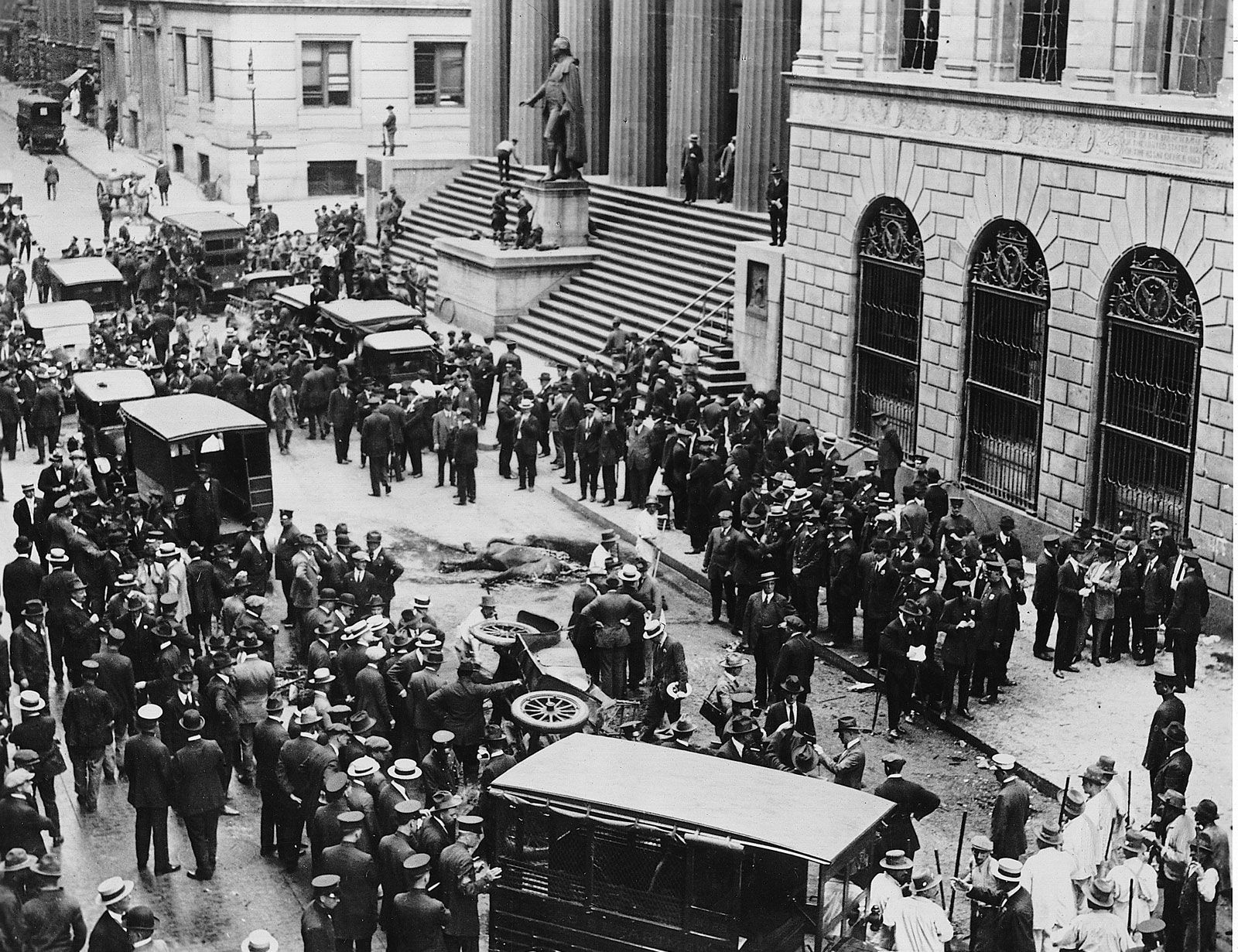The Wall Street Bombing of 1920: A Forgotten Terrorist Attack
On September 16, 1920, a horse-drawn wagon exploded in front of the headquarters of J.P. Morgan & Co. at 23 Wall Street, killing 38 people and injuring hundreds more. It was the deadliest terrorist attack in New York City until the 9/11 attacks in 2001. Yet, the perpetrators and their motives remain unknown to this day.
What happened on that fateful day?
The explosion occurred at 12:01 pm, when Wall Street was bustling with people heading for lunch. The wagon, which was parked across the street from the J.P. Morgan building, contained 100 pounds of dynamite and 500 pounds of iron sash weights. The blast shattered windows, damaged buildings, and sent shrapnel flying in all directions. The horse and wagon were reduced to fragments, but the driver was never identified or caught.
The victims were mostly young people who worked as messengers, stenographers, clerks, and brokers. Many of them suffered severe injuries and died later in hospitals. The bomb also caused more than $2 million in property damage (equivalent to about $27 million today). The scene was described as a "war zone" by witnesses and reporters.
The police and soldiers arrived quickly to help the wounded and secure the area. The New York Stock Exchange suspended trading to prevent a panic. The investigation began immediately, but no conclusive evidence was found at the site.
Who was behind the attack and why?
The Wall Street bombing was never officially solved, despite several theories and suspects. The most widely accepted explanation is that it was an act of terrorism by anarchists or communists who wanted to strike a blow against American capitalism and its symbols.
This theory was supported by a stack of flyers found in a mailbox near the scene. The flyers read:
> Remember
> We will not tolerate any longer
> Free the political prisoners
> or it will be sure death for all of you
> American Anarchist Fighters
The flyers were signed by the "American Anarchist Fighters", a group that was never heard of before or after the bombing. Some investigators believed that the flyers were a red herring planted by the real culprits to divert attention from themselves.
Another possible motive was revenge for the arrests of Sacco and Vanzetti, two Italian anarchists who were convicted of murder and robbery in a controversial trial in 1921. Some historians have suggested that the bombing was carried out by Galleanists, followers of Luigi Galleani, an Italian anarchist leader who advocated violence against the state and its agents. Galleanists were responsible for a series of bombings in 1919 that targeted politicians, judges, and businessmen.
Other theories include an attempt to rob the nearby Sub-Treasury Building, where $900 million in gold bars was being moved that day; an assassination plot against J.P. Morgan Jr., who was in Europe at the time; or a random act of violence by a mentally unstable person.
What were the consequences of the attack?
The Wall Street bombing shocked and outraged the public and the authorities. It also fueled the fear and paranoia that characterized the Red Scare of the early 1920s, a period of intense anti-communist sentiment and repression in the United States.
The bombing prompted increased security measures and surveillance on Wall Street and other financial centers. It also led to more arrests and deportations of suspected radicals and immigrants under the Palmer Raids, a series of raids conducted by Attorney General A. Mitchell Palmer and his assistant J. Edgar Hoover.
The bombing also had an impact on the cultural and artistic scene of New York City. It inspired several works of fiction, such as John Dos Passos' novel Manhattan Transfer (1925), F. Scott Fitzgerald's short story "The Diamond as Big as the Ritz" (1922), and Thomas Pynchon's novel Against the Day (2006). It also influenced artists such as Edward Hopper, who painted several scenes of Wall Street after the bombing.
Why is the Wall Street bombing forgotten?
Despite its magnitude and significance, the Wall Street bombing has faded from public memory over time. One reason is that it was overshadowed by other events in American history, such as World War I, World War II, and the Great Depression.
Another reason is that it was never officially solved or acknowledged by the government or the media. The lack of closure and accountability may have contributed to the collective amnesia about the attack.
However, some traces of the bombing still remain in New York City. The facade of the J.P. Morgan building still bears the scars of the shrapnel, and a plaque commemorating the victims was installed in 2016. The bombing is also remembered by historians, writers, and activists who seek to uncover its mysteries and lessons.
The Wall Street bombing of 1920 was a tragic and violent event that marked a dark chapter in American history. It also serves as a reminder of the dangers of extremism, intolerance, and injustice in any society.
Source:
FAQ's
Was the Wall Street bombing a terrorist attack?
Thirty-nine people died and hundreds more lay wounded, making the Wall Street explosion the worst terrorist attack in U.S. history until the Oklahoma City bombing.
What was the reason for the Wall Street bombing?
The bombing was ultimately decided to have been an act of terrorism performed by “Reds”—anarchists and communist sympathizers—who wanted to shatter the symbols of American capitalism. A stack of anarchist flyers found in a mailbox a block away from Wall Street supported this theory.
What happened on Wall Street on September 16 1920?
Photographs showing the aftermath of bombing in the Wall Street financial district in New York on Sept. 16, 1920. Library of Congress photos. Click the images for higher resolution versions.







0 Comments